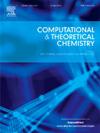过渡金属MII/GdIII配合物(M = Co和Cu)电子结构和磁性能的密度泛函理论研究
IF 3
3区 化学
Q3 CHEMISTRY, PHYSICAL
引用次数: 0
摘要
用相对论DFT研究了两种混合的MII和GdIII双金属配合物的通式:LMGd(μ-O2CCH3)(O2CCH3)2 (M = Co和Cu)和(L = 6,6 ' -((1E, 1E)-((2,2-二甲基丙烷1,3-二基)双(azanylylidene))双(methanylylidene))双(2-甲氧基苯酚)。计算是在标量相对论的ZORA/B3LYP/TZP水平上进行的。首先,优化后的几何形状与x射线的几何形状吻合较好。用破对称方法在同一理论水平上计算了磁交换耦合常数。利用完全优化的几何结构,我们得到了以下耦合常数,分别为J = +0.26 cm−1和J = +1.49 cm−1,表明这两个配合物具有铁磁性,其值与实验结果接近,即J = +0.22 cm−1和J = +2.6 cm−1。结合自然居群分析(NPA)和多极衍生电荷分析(MDC),结合MO图、原子自旋密度分布对其电子结构进行了合理化。自旋居群的分析表明,Gd(III)离子的7个4f未配对电子在金属中心定位,而M(II)离子的3d电子则发生了明显的离域。研究了Cu-O-Gd角对磁性行为的驱动作用。结果表明,当实际角度为103.44°时,磁芯内键序达到最大值,磁芯氧自旋居数达到最大值,有利于超交换机制的发生;同时,得到了耦合常数的最大值。本文章由计算机程序翻译,如有差异,请以英文原文为准。

Density functional theory investigations of the electronic structure and magnetic properties of transition metal MII/GdIII complexes (M = Co and Cu)
A relativistic DFT study of two mixed MII and GdIII bimetallic complexes with the following general formula: LMGd(μ-O2CCH3)(O2CCH3)2 with (M = Co and Cu) and (L = 6,6′-((1E,1′E)-((2,2-Dimethylpropane1,3-diyl)bis(azanylylidene))bis(methanylylidene))bis(2-methoxyphenol) has been carried out. The computations have been conducted at the scalar relativistic ZORA/B3LYP/TZP level. First, a good agreement between the optimized geometries and the X-ray ones has been obtained. The computation of the magnetic exchange coupling constants using the Broken Symmetry approach (BS) at the same level of theory has been done. Using their fully optimized geometries we obtained the following coupling constants, indicating a ferromagnetic character for both complexes, J = +0.26 cm−1 and J = +1.49 cm−1 respectively, values close to the experimental results, namely J = +0.22 cm−1 and J = +2.6 cm−1. The electronic structures have been rationalized considering the MO diagrams, the distributions of atomic spin densities, in conjunction with Natural Population Analysis (NPA) and Multipole Derived Charge (MDC) analysis. The analysis of the spin populations indicates the localization of the seven 4f unpaired electrons of the Gd(III) ion on the metal center, whereas a significant delocalization of the 3d electrons of the M(II) ion occurs. The driving role of the Cu-O-Gd angle on the magnetic behavior has been investigated. It is found that the actual angle value i.e. 103.44° insures the highest values of the bond orders within the magnetic core, the core oxygen spin populations reaching their maximum value, favoring the superexchange mechanism; concomitantly, the highest value of the coupling constant is obtained.
求助全文
通过发布文献求助,成功后即可免费获取论文全文。
去求助
来源期刊

Computational and Theoretical Chemistry
CHEMISTRY, PHYSICAL-
CiteScore
4.20
自引率
10.70%
发文量
331
审稿时长
31 days
期刊介绍:
Computational and Theoretical Chemistry publishes high quality, original reports of significance in computational and theoretical chemistry including those that deal with problems of structure, properties, energetics, weak interactions, reaction mechanisms, catalysis, and reaction rates involving atoms, molecules, clusters, surfaces, and bulk matter.
 求助内容:
求助内容: 应助结果提醒方式:
应助结果提醒方式:


